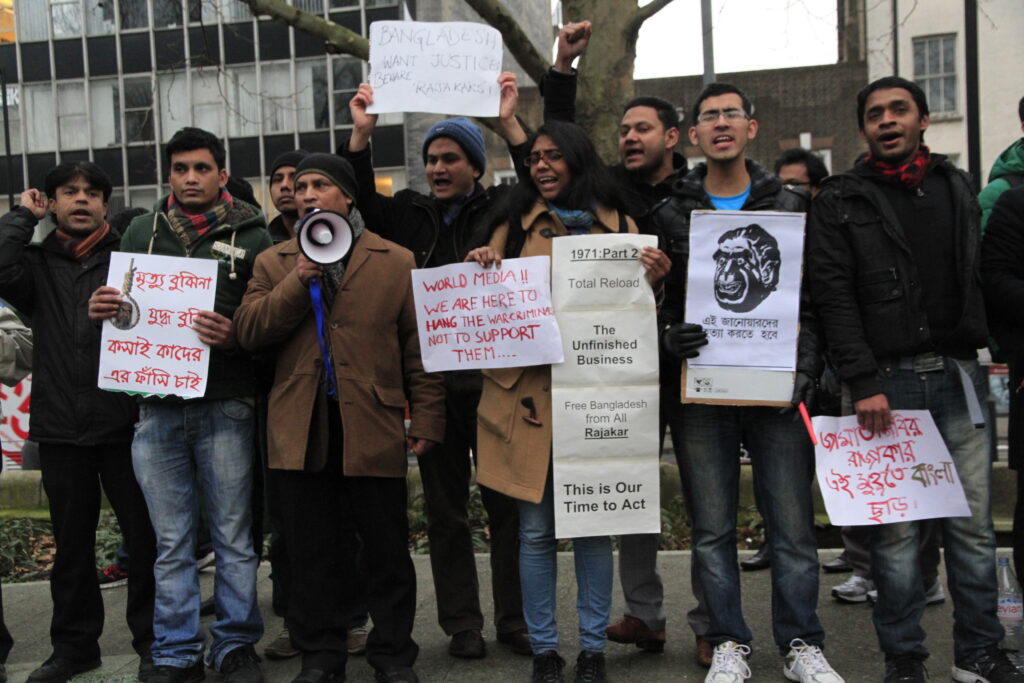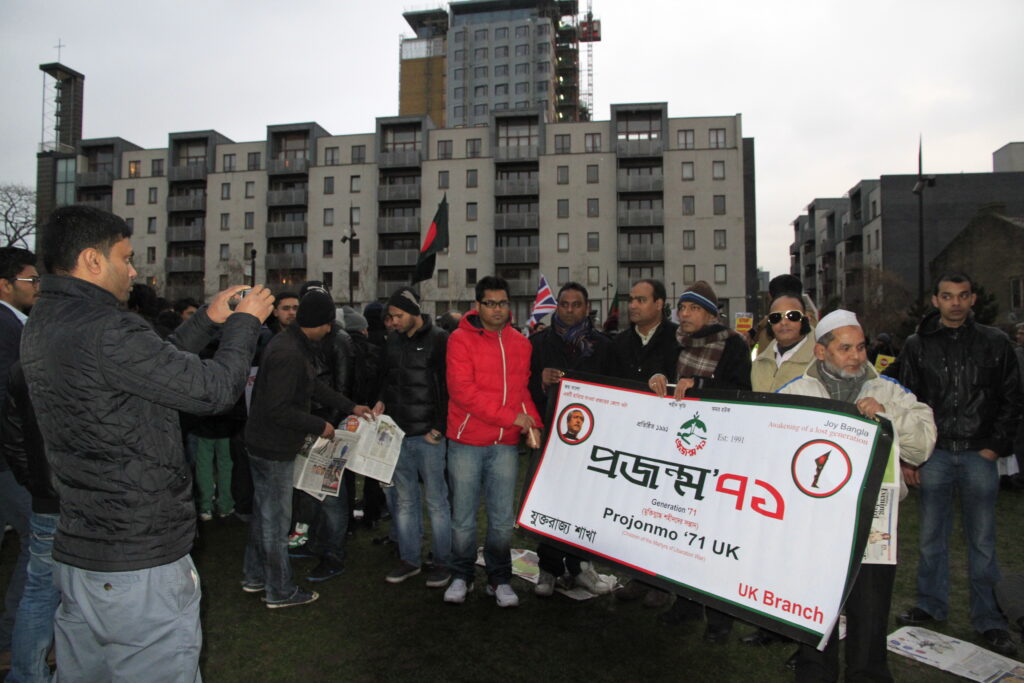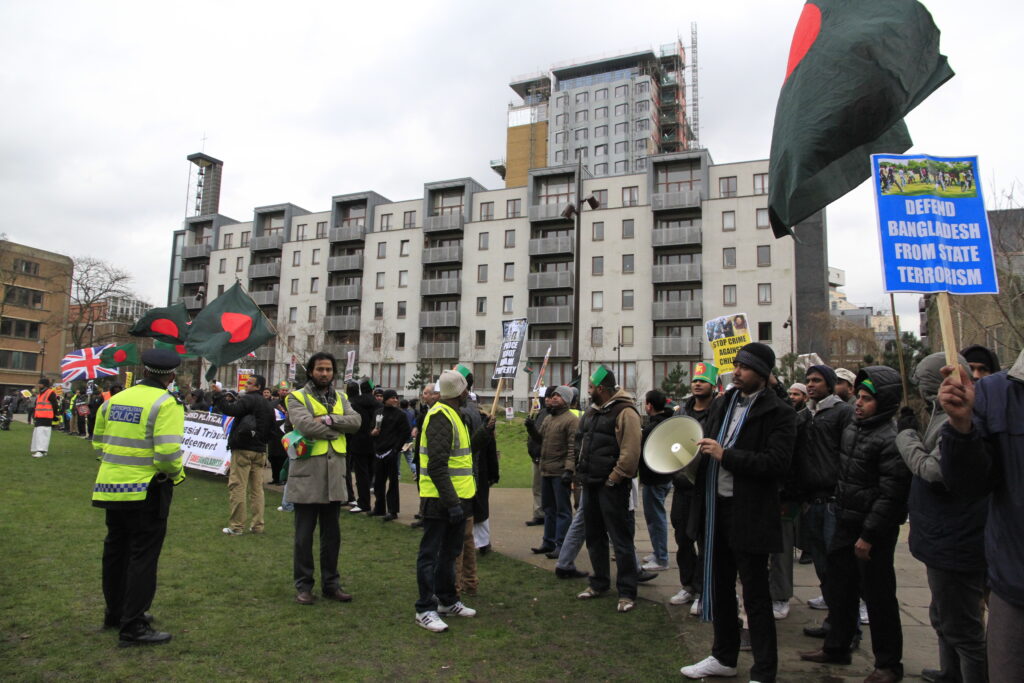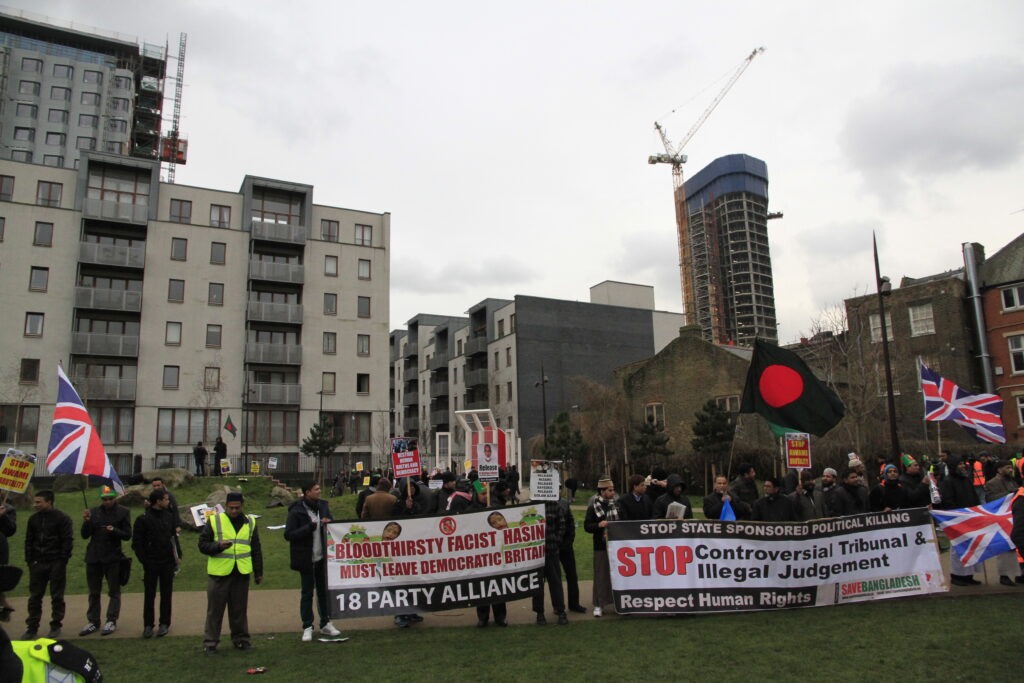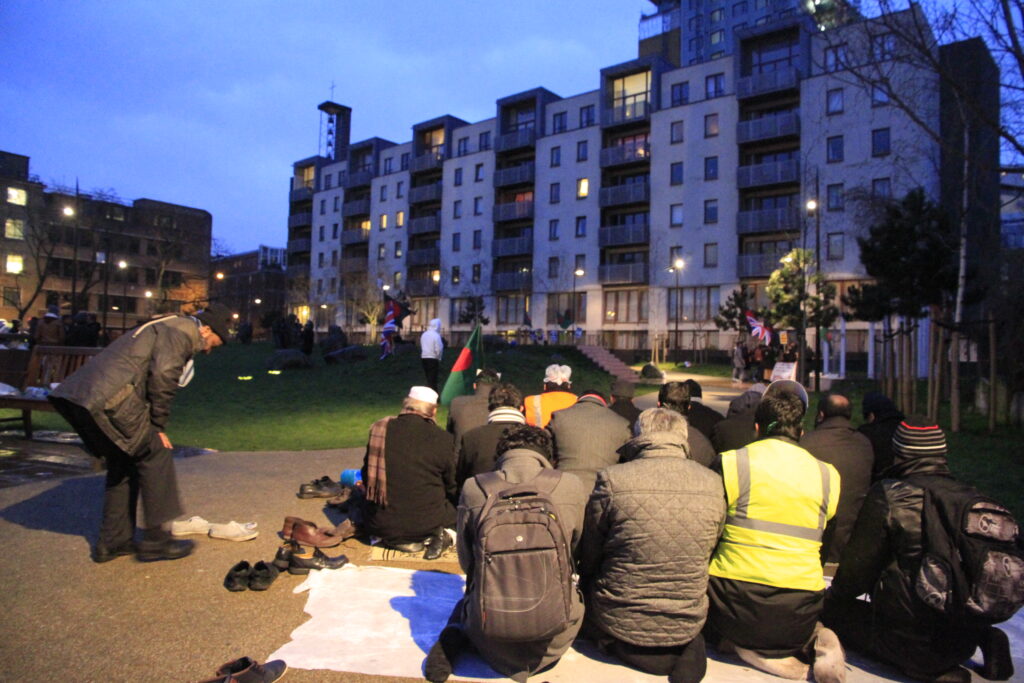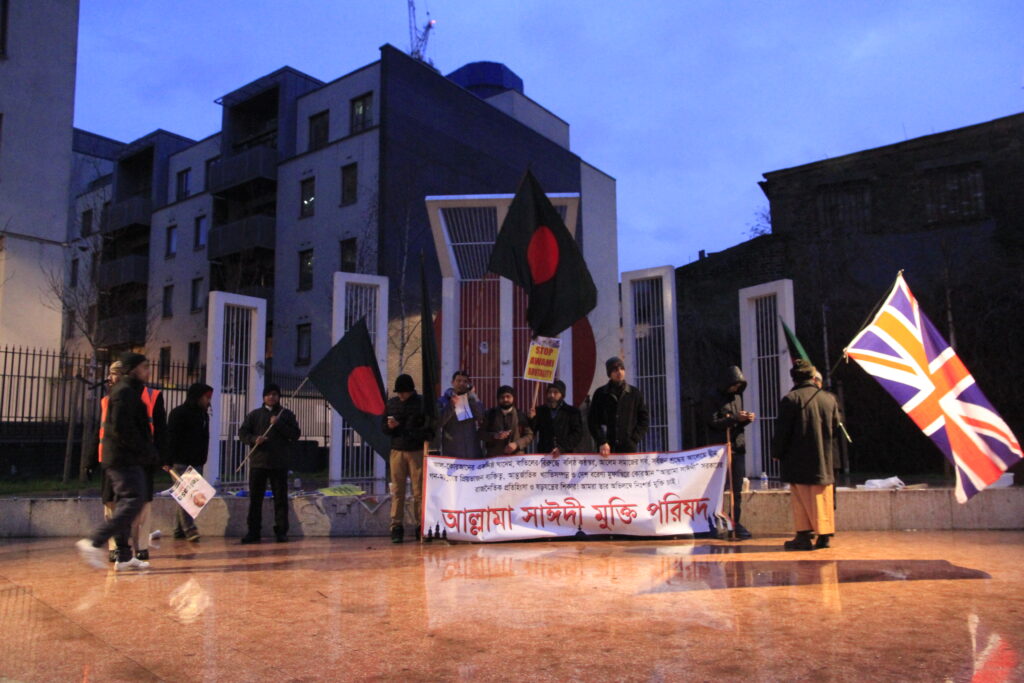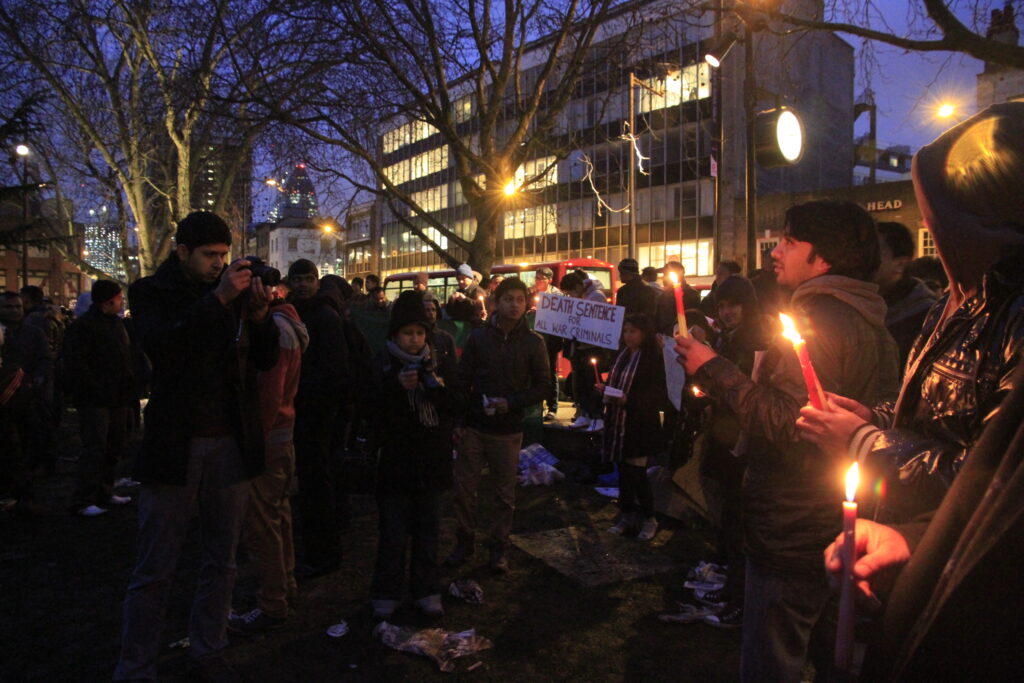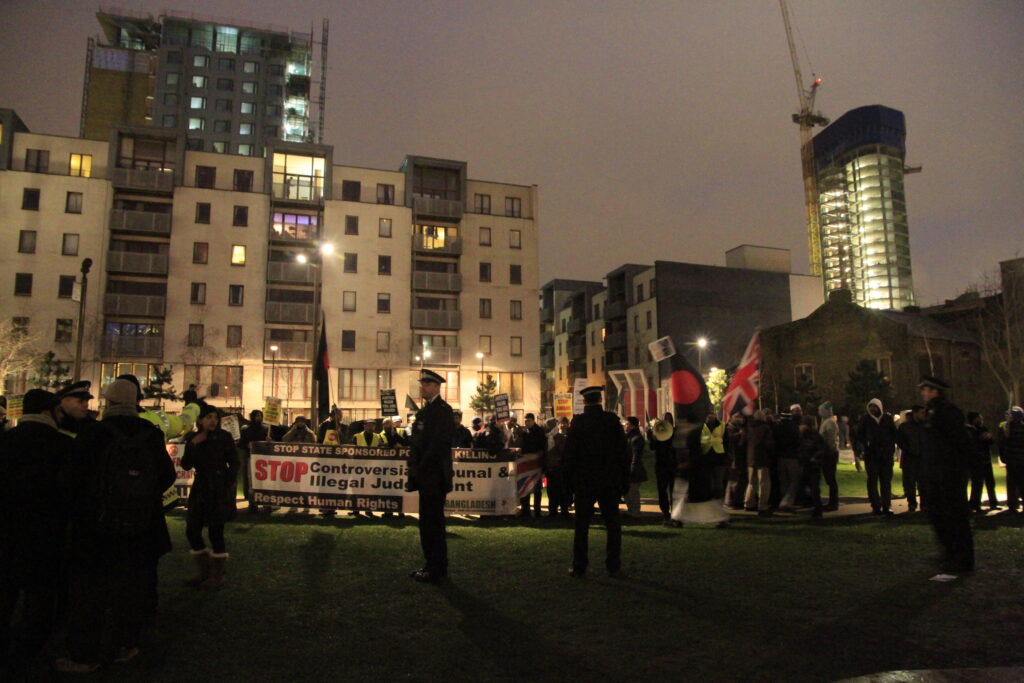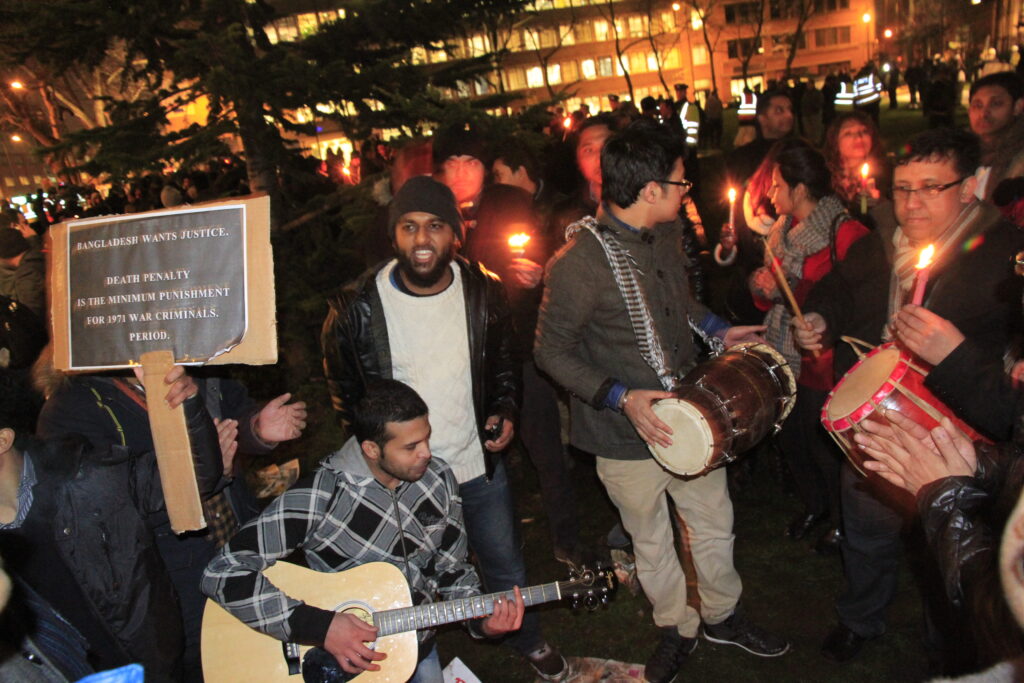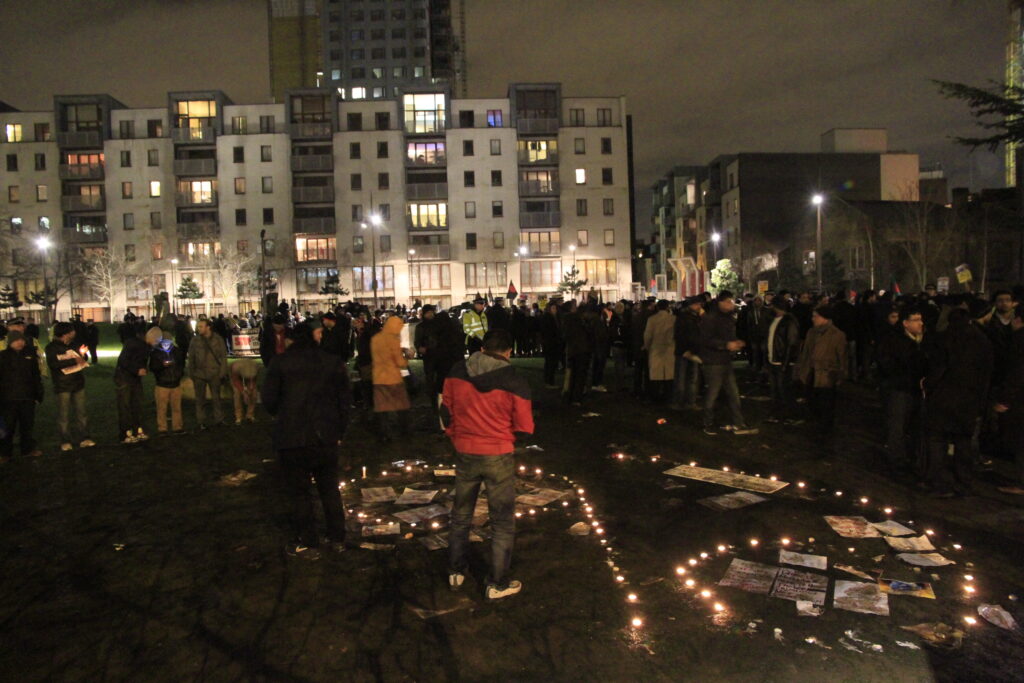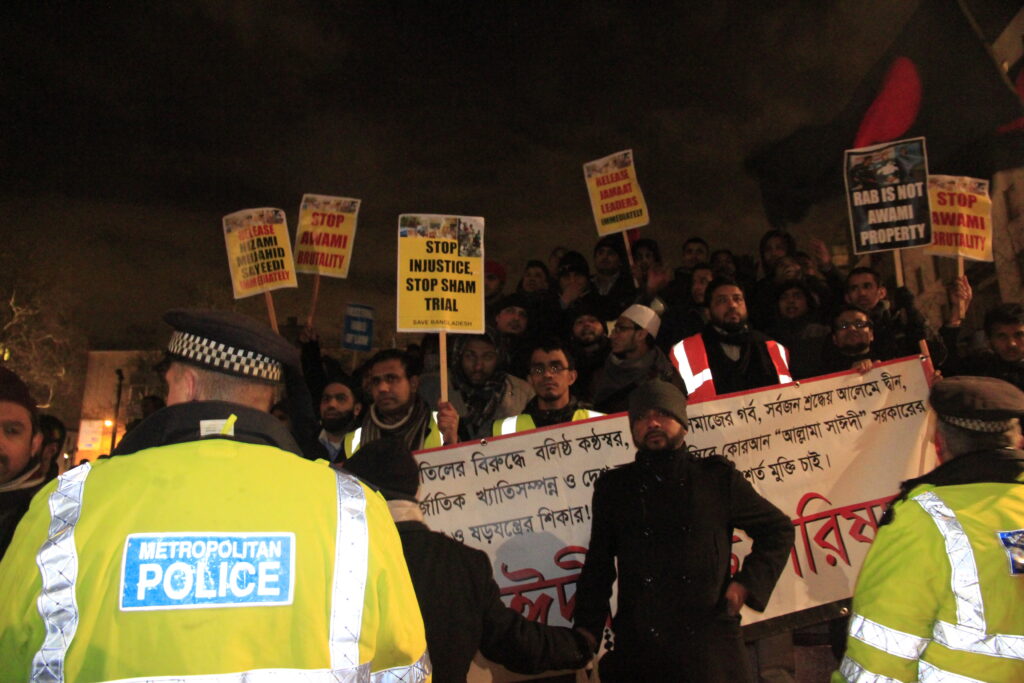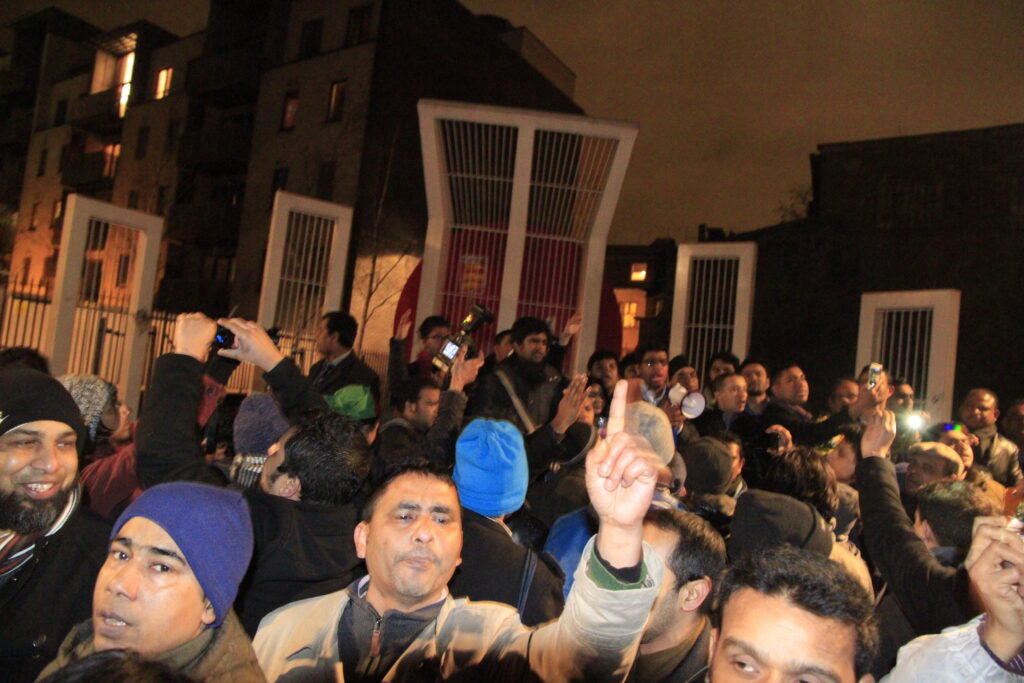
An opinion piece by M Ahmedullah, first posted on 7 February 2015
February 2023 is the tenth anniversary month of the start of the Shahbagh Movement. I am reposting a slightly edited version of the writing I originally posted on Facebook in February 20215, on the second anniversary of the Shahbagh Movement.
The unprecedented movement started on 5th February 2013 and continued for several months before the Awami League government dismantled the ‘Gono Jagoron Moncho’ (Mass awakening stage) and other facilities established to support its programmes and campaigns.
The movement started, as has been popularly narrated, when a group of online bloggers became angry at Kader Mollah for showing a V-sign (victory) when he escaped the death penalty sentence, although convicted of ‘rape and mass murder’ by the Bangladesh War Crimes Trials.

He was sentenced to life imprisonment for his crimes as judged by the tribunal created to bring war criminals of the 1971 Bangladesh Liberation War to justice. By the time the government started to pull down the movement’s infrastructure in Shahbagh, it was already in a state of decline. The government’s action only sped up the process of the Shahbagh phenomenon becoming insignificant.

Many people join movements such as the one that took place in Shahbagh in Bangladesh out of idealism – even if, in some instances, the ideals are not positive and good – because they want to promote their politics. Some people join movements out of fear or peer pressure, which includes the fear of being labelled as ‘you are with them because you are not with us’. Among the reasons why many young people positively supported the Shahbagh Movement, especially women, were, perhaps, because deep down, they were fearful of the influence of Islamic political parties and religious leaders on society.
However, calling for the hanging of ‘war criminals’ with extreme emotion, irrational zeal and singing beautiful songs, some demanding and others pleading for fachi (hanging) – even when the process of trying ‘War Criminals’ in Bangladesh was at that time wholly discredited as partisan, politicised and incompetent – meant that the supporters had no chance of successfully arguing that it was a positive and moral movement.
(Some songs sung in Shahbagh during the movement in 2013, directly pleading for hanging through beautiful voices, are no longer on YouTube).
The movement’s demands were associated with too many wrong elements, and it lacked any sense that it was looking for justice or seeking the truth. Instead, the movement became characterised by extreme propaganda, hatred of those they othered, demanding the banning of political parties, chanting Awami League partisan slogans, requesting the authorities to undertake judicial murders, etc.

The Shahbagh Movement demanded the hanging of alleged war criminals even before they were proven guilty through an internationally credible legal process that has respect and confidence from all sides and the public in Bangladesh and worldwide. In the eyes of the world, the tribunal process in Bangladesh legal process was a complete sham. Probably some people around the world were laughing (those who did not care), and those who cared were perhaps concerned and worried. Moreover, the movement demanded banning a small party that only got about 5% of the vote in the last election in which it participated. People probably wondered if their support base was so small, why ban them and hang some of their leaders? Is it not better to try to win the arguments by debating and taking on the Jamaatists with words rather than trying to destroy them with the sword?

Although the Shahbagh Movement went up and down very quickly, it was nevertheless extremely significant for Bangladesh – albeit for a very short while. The few months of its life were a very tense period for the country. It allowed more than a century of pent-up feelings of Bengali Nationalism to come to the fore with a short-lived period of confidence characterised by an emotionally charged rage and self-righteous fury. The rage sometimes looked like a mass hysteria – or at least how it appeared on media reporting – when the crowd gathered at the Shahbagh intersection was, relatively speaking, quite large.
The intensity of emotions released by the movement was like an earthquake that shook the foundations beneath us all. It was equally experienced by the supporters of what was going on at Shahbagh and those worried about its potential negative implications. Although the actual number of individuals who attended the place day after day for several months was not noticeably big, with a few exceptions, and varied in their numbers, people all around Bangladesh and in the Bangladeshi Diaspora were intensely gripped over the period by the fast-moving developments taking place at Shahbagh. On the one hand, the movement positively electrified one section of the people who felt that they were finally creating their own dawn, while some others were in a state of fear and tension, worried about the rapidly increasing power of Bengali Nationalism being delivered by the movement at the ‘Gono Jagoron Moncho’.

Although the Shahbagh movement was planned, started and sustained by the Awami League and their supporters (my speculation), for a while from the beginning, it took a semi-independent life of its own where the majority of the participants thought they were non-politically partisan actors engaged in a right cause and making history. However, at the beginning, and for a considerable amount of time during the movement, I do not doubt that most participants did not know how they were being used and controlled by the Awami League. As time passed, this realisation began to dawn on more and more people; as such, the numbers coming to Shahbagh in support of the movement started to go down. The government saw diminishing returns of continuing the movement and feared that it might become counter-productive, due to the wave, at that time, being created by the Hefazot counter-movement. As such, it moved against the tiny number of people still appearing at Shahbagh and dismantled and closed down all the facilities set up since February 2013. The people who were strong vocal supporters of the movement did not go out to defend the ‘Gono Jagoron Moncho’ when the Awami League government demolished the ‘stage’. This must say something about the movement and its participants and supporters.

The Shahbagh Movement was presented, by many supporters, as the expression of angry urban youths who were fed up with negative politics in Bangladesh. They gathered to promote a modern and rational identity of secularism and Bengali nationalism for the country, as opposed to the politics that espoused a communal anti-liberation ideology. As the new generations of youths became fed up with negative politics, religious identity and social restrictions, they came out to make a break with the past and start a new era of positive politics, rationalism, Bengali cultural identity and secularism. Some of the young participants sang songs pleading for the execution of those who they considered war criminals and razakers. Many young students from various educational institutions were brought to Shahbagh to support the movement, still wearing school uniforms. Some parents brought their children, some of whom had messages written on their bare chests, the back of their bodies and on their faces, including the use of some English swearing words directed at what they called ‘razakars’, ‘war criminals’ and ‘anti-liberation forces’.

One enthusiastic supporter of the Shahbagh Movement wrote in a foreign media outlet that some in Bangladesh considered what was happening in Shahbagh to be similar to the French revolution. Another person in a Facebook posting wrote that we are ‘Fighting people who are anti-Bangladesh, anti our very own existence’. There was also a suggestion by someone else that the movement was playing a ‘crucial role’ and ‘opening our eyes to the dangers that lay lurking within our own social body’. One commentator suggested that this was the ‘silent majority rising up against the use of religion to bully, the issuing of bewildering fatwas, the adoption of Arab dress and Arab ways, the blatant distortion of the past, the peculiar assault on our culture…’ and ‘rising up against …. the adoption of Arab dress and Arab ways’. When the Hefazot movement started, one person alerted fellow movement supporters on Facebook and asked the question, ‘are we ready to face the counter-movement?’ (my paraphrase).
The above are some examples from a multitude of views expressed by relatively more intelligent supporters of the movement. They can be described as urban, secular elites with Bengali nationalist tendencies. They imagined themselves participating in an extraordinary revolutionary time, overturning the old order and creating a new beginning similar to what they read in books on famous revolutions, such as the French Revolution of 1789, the Bolshevik Revolution of 1917, etc. However, this was quite odd and delusionary to me as their ‘French Revolution’ was not directed against the government in power or the Bangladeshi state.

I found some of the views expressed by the supporters of the Shahbah Movement to be very bizarre, disappointing and delusionary. How it was possible for some of the more intellectual supporters of the ‘Gonojagoron Moncho’ to talk such nonsense was difficult to understand at first. The immorality of the movement was very clear to me from the beginning, and the contradictions contained within the movement meant that it would also decline fast when it reached its peak. Something which rises very quickly also declines very fast as the high-speed rise does not allow one sufficient time and effort to build strong foundations en route before moving up to another higher level and building another strong foundation before a further upward move and so on. High-speed rise means weak foundations built quickly along the way or no foundation at all and without the meticulous calculation of how structural engineers ensure solid foundations of structures.
The immorality of the movement was the calling of the ‘hanging of war criminals’ and sometimes even of the ‘razakars’, rather than demanding justice. When demand is based on immorality, the moral foundation needed to sustain a movement where self-sacrifice is often required is absent. The justification for the immoral position gets undermined within the souls of conscientious supporters, which starts to cause confusion and pain within them. Immoral demands cannot be sustained for long as the feelings of the rightness of something that, in the first place, provided the energy for the people to join, sustain and even sacrifice, if necessary, decline, especially when facing strong counter-narratives. As a result of the immoral demands of the movement, which manifested in many immoral actions also, the Shahbagh Movement was destined to fall as fast as it rose. This is what I thought from the beginning of the movement and what I witnessed of the movement’s fall.
I was also very disappointed because the so-called cream of our society should have had more sense and come to the correct realisation sooner. Unfortunately, this was not the case, as they lacked the necessary intellectual and critical capacity to understand the Shahbagh Movement for what it was in reality. They either chose to deliberately or were forced by the logic of their Bengali nationalist upbringings and the mutual reinforcing of one-sided worldviews and narratives to view the other side in the most evil manner as possible in their imagination. Emotionally many of them still support some elements of the movement and wish things turned out differently within the so-called spirit of liberation, Bengali Nationalism and secularism, which gave them so much short-term hope and empowering experiences. However, many of them now feel very embarrassed at how things have turned out and realised that the ruling Awami League party badly used them.
During the movement, I also participated in social media debates as I wanted to point out the madness and dangerous potentials of the Shahbagh phenomenon to help bring some sense to people captured by the movement. I also wanted to empower those who were at the receiving end of the Shahbagh’s rage, as I thought a powerful coalition of forces in Bangladesh was, with immorality and without justification, targeting people who have been othered and made illegitimate with false historical interpretations and narratives and the powerful use of the arts. My engagement consisted of both criticisms of some published articles/Facebook postings and original thoughts on the movement.
Some of my responses to some of the nonsense are provided next. The idea that this movement was the ‘rising up against …. the adoption of Arab dress and Arab ways’, I thought, was incredibly bizarre. The majority of the people of Bangladesh are Muslims, and they have a special love for the birthplace of the Prophet, and it is natural for many to want to wear dress styles of Arabia. There is nothing wrong absolutely in this desire. This bizarre idea comes from a bankrupt emotion of blind nationalism, contradictory passions and fascistic mentality. Today in Bangladesh, more people wear western dress and are increasingly adopting more and more western ways. There is nothing wrong with this, either. I wear western dress, Bangladeshi longi and Punjabi and Indonesian batik shirts, and I am proud of what I wear.
The above claim appearing in several Bangladeshi and foreign media publications made me think about it, and I wondered where such ideas could originate. I am also quite certain that this author wears western dresses just like me, and I do not think that the author of the above nonsense is aware of the contradictions involved and the incredible silliness of the expressed views. The reason I do not think the author is aware of the contradiction is that I think she has never thought about the issues carefully, as her views are clearly formed by blindly accepting some of the assumptions and worldviews of Bengali nationalism that see ‘Islamic/Muslim outside influences’ on our culture as something to fight against. In contrast, outside western influences are acceptable and to be welcomed. This is the case even though 90% of the people of Bangladesh are Muslims, and their culture is based on eight long centuries of deep Islamic cultural developments within the country through interactions with local and outside influences.
Concerning another strange claim, I responded on Facebook and said that by making a baseless claim that you are ‘Fighting people who are anti-Bangladesh, anti our very own existence’, without providing arguments and empirical evidence, you also have joined many others who have poisoned our people with baseless propaganda. In relation to the idea that Shahbagh was the “silent majority rising up against the use of religion to bully, the issuing of bewildering fatwas, the adoption of Arab dress and Arab ways, the blatant distortion of the past, the peculiar assault on our culture’, I pointed out that if a religion-based party was not in power then how could such a movement be a ‘rising up against the use of religion to bully’. With regard to the idea of ‘peculiar assault on our culture’, I pointed out that both sides have been involved in the fight against our cultures. One side was fighting against the 800 years of Bengal Muslim culture, and the other was against the narrow idea of Bengali culture and its limited practice in Bangladesh.
One commentator expressed disappointment at not getting much foreign media coverage of their revolution in ways similar to the attention that Egypt’s Tahrir Square got. I wrote a Facebook post where I responded by stating that a secularist party was currently in power in Bangladesh with more than a two-thirds majority in the parliament. Some people may wonder what this Shahbagh Movement was for as it supports (clear from the dominant voice within Shahbagh) and is supported by the present government in power. Usually, such a movement captures world attention if the people involved fearlessly face a long oppressive tyrant’s power, tanks and coercive forces. They have moral energy and morality on their side, which energise them to stand against injustice and immorality. In this case, the government tanks and bullets are not trying to shoot and disperse them; rather, the government is trying to bolster and use the Shahbagh Movement for their propaganda and political purposes. Is it not a big delusion to expect foreigners to take a big interest in such a movement?
One online commentator thought that the Shahbagh movement was behind Jamaat on their international outreach and profile because much of their activities were being carried out in Bangla. This might be one among many factors in this regard. However, I thought there were deeper reasons why the Shahbagh Movement was not going to have much luck with the international community in terms of gaining support for their causes and demands. The supporters of this movement, both Bangladeshi and non-Bangladeshi, were active all around the world with their placards, demonstrations and writings in newspapers/magazines/blogs. There has been some positive western media coverage of the Shahbagh Movement in several mainstream western media, but they were primarily written by lightweight, insignificant and hardly known commentators. As far as I know, no heavyweight western media commentators, politicians or academics have voiced their support for the Shahbagh Movement. This is also true for the world in general. I may not be entirely right, and will be corrected when I see the evidence.
In their guts, many western people and people around the world may feel sympathy with the Shahbagh young people aspiring to be free and promoting freedom, but they know that rule of law and due process are at the heart of all progress. So, how can they support a movement that has been linked to a disreputable legal and political process taking place in Bangladesh? John Locke, the well-known English philosopher in the 17th Century, famously said that where there was no law, there was no freedom.
The Shahbagh Movement went even further than what the Bangladesh government had done. They demanded that the trial process become dodgier than it had already become. I asked the supporters of the Shahbagh Movement through Facebook postings, ‘do you think that these immoral demands of the Shahbagh Movement will help inspire people around the world?’ For me, the answer was a clear no.
How can one explain the Shahbagh movement, which came from nowhere and disappeared very quickly? Although it collapsed very quickly when it ran out of steam and support from the government, it did, however, captivate Bangladesh and Bangladeshis everywhere for several months and has left its traces in people’s minds in various ways. When it was rising, the sheer power of the movement, which both inspired and created fear in people in equal measures, meant that there must be something more deep and important underlying factors which came together at a certain point in time that triggered the release of so much energy.
The Shahbagh Movement was like a chain reaction caused by the coming together of a number of important factors. When the trigger button was pressed, it created a nuclear-like explosion, which started from Shahbagh Chottor and spread with lightning speed in every direction reaching far corners of the world. However, unlike a real nuclear explosion, it seems that the Shahbagh movement lacked adequate quality fuels within itself to sustain its fire for long, causing its speedy decline and collapse after reaching the peak quickly.
I have come to the conclusion that the movement’s main energy sources came from Bengali nationalist interpretations of history and how they view and understand the meaning of the term culture and apply it to ‘Bengali culture’. These energy sources of Bengali nationalism, which went unchallenged for a long time, were monopolised in our society and determined our outlook and ideas of right and wrong (inclusion and exclusion). These include the history of the past going back about two millenniums to the liberation war and subsequent developments in Bangladesh. The Bengali Nationalists’ interpretations of the 1971 Bangladesh Liberation War were centred around the idea that 3 million people were killed and 200-400,000 women were raped and built on the generalised views of a small middle-class urban elite in Bangladesh. Accordingly, the war caused the horrendous killings of 3 million people by the Pakistanis and their main armed supporters, mostly Jamaatists. Those killed were mostly unarmed civilians and many intellectuals.
The Bengali nationalists defined what constituted human culture and set legitimate perimeters for ‘Bengali culture’, which treated 800 years of deep Islamic influences on Bengali culture as alien and foreign, linked to the ‘Muslim invasion of India’, not worthy of being considered part of Bengali culture. The unchallenged interpretations of the Bengali nationalist version of history and the promotion of their worldview, primarily through music, drama and poetry, meant that a large number of people in Bangladesh grew up developing an uncritical self-righteous view of right and wrong concerning our history and our ways of life. The right and wrong defined by a poor knowledge base of history and Bengali nationalists’ view of what constitutes Bengali culture were, in my view, the main ingredients behind the Shaghbagh explosion of February 2013. However, as the ingredients of the movement were not based on strong foundations built on science and objective research, the impacts of the explosion were short-lived and destined never to repeat or return again.
As a result of the fury of the Shahbgah movement, people at the receiving end have realised how the current interpretations of history, where the Bengali nationalist version dominates, create disadvantages for them and give unjustifiable powers to Bengali nationalists. An increasing number of people of Bangladeshi origin feel that there is a need to move away from political and ideological interpretations of history. The desire to learn history through scientific methods and objective studies means that the hold of the Bengali Nationalists’ interpretations of history will become less and less dominant in our society in the future.
The bad experience of those who supported the Shahbagh Movement and gave its strength at the beginning by being present at the Shahbagh Chottor or writing supporting comments and articles mean that they cannot be inspired to come back to support a similar movement again. Moreover, the loss of the dominance of the Bengali Nationalists’ interpretations of history and the development of alternative definitions of what constitutes human culture and Bengali culture means that the particular combination of ingredients that gave rise to the Shahbagh movement, which kept us sleepless for a few months, is not likely to be available ever again to the Bengali nationalists. As such, I feel the Shahbagh Movement was the last fury of Bengali nationalism
Footage of Shahbaghists and Jamaaatists confrontation in Altab Ali Park, London, 8 February 2013.
